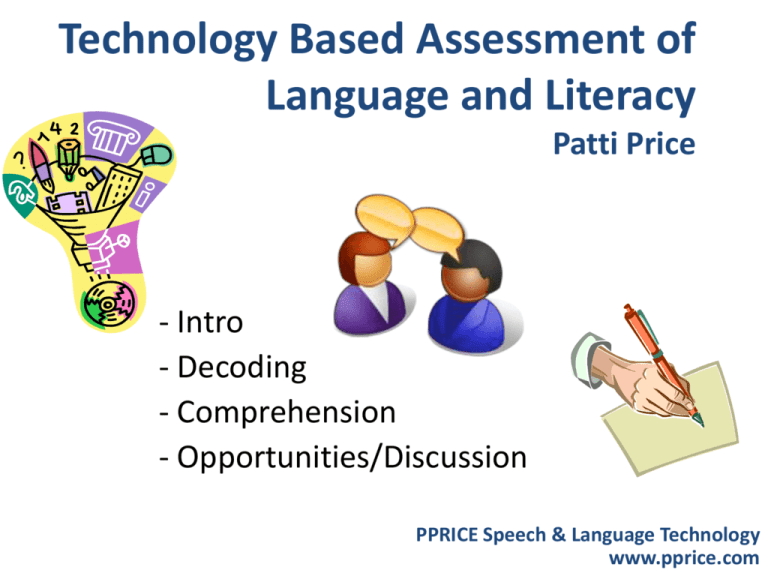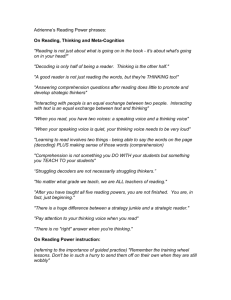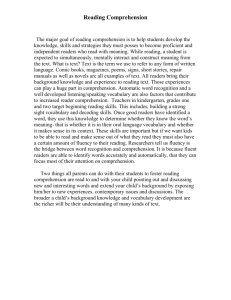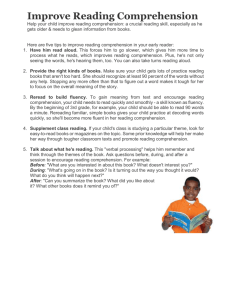PPTX
advertisement

Technology Based Assessment of Language and Literacy Patti Price - Intro - Decoding - Comprehension - Opportunities/Discussion PPRICE Speech & Language Technology www.pprice.com • Intro • Decoding • Comprehension • Discussion Evolution, primates to humans, millions of years ago -60 -50 -40 -30 -20 -10 Primates 0 Gorillas Humans to the leap Humans -7 -6 -5 -4 -3 -2 Stone tools Humans Fire -1 0 Shelter Language: ~ 50,000 years ago Spears •Clothing •Burial Farming, 10,000 years ago •Hunting Bronze, 5500 years ago •Art Written language: ~5 – 6,000 years ago • Intro • Decoding • Comprehension • Discussion Pre-language: Information access by direct experience Multimedia: The power of direct experience, but not limited by time, place, language, learning style, sensory abilities… Oral language: Information access also from someone in same time and place with same language Written language: Information access not limited by time and place Written and Spoken Language are Different • • • • • Intro • Decoding • Comprehension • Discussion These differences are important in learning to read. How difficult it is to spell (many letter combos to one sound) How difficult it is to read (many sounds for the same letter) How closely your dialect matches written conventions “Got to say this for you, you got guts. Guts and no brains. But guts alone don’t mean nothin’. “ “I gotta say this for you-- you have guts. Guts and no brains. But guts alone mean nothing.” I’ve got to say this for you: You have guts. You have guts and no brains, but guts alone mean nothing. Differences Between Speech and Writing Vocabulary Distinct words Sentence length Sentence structure Grammar Prosody Written ‘things’… 20,000+ 10 – 30 words Complex Conservative A . , ! ? ; : () • Intro • Decoding • Comprehension • Discussion Spoken ‘stuff’ 2,000+ ? shallow Liberal Rich Example • Intro • Decoding • Comprehension • Discussion ~130 words (1) I’ve been talking – I’ve been multiplying matrices already, but certainly time for me to discuss the rules for matrix multiplication. (2) And the interesting part is the many ways you can do it, and they all give ~45 words the same answer. We’ve been (3) So it’s – and they’re all important. multiplying matrices. (4) So matrix multiplication, and then, uh, come inverses. Now let’s discuss the (5) So we’re – uh, we – mentioned the inverse of a matrix, but there’s – rules for matrix that’s a big deal. multiplication. Note (6) Lots to do about inverses and how to find them. that there are many (7) Okay, so I’ll begin with how to multiply two matrices. (8) First way, okay, so suppose I have a matrix A multiplying a matrix B and – to do it and get ways giving me a result – well, I could call it C. the same answer. (9) A times B. Okay. One way to multiply (10) Uh, so, l- let me just review the rule for w- for this entry. two matrices, A and B, to get a new Transcript from a linear algebra lecture (From Glass, Hazen, Lee and Wang, matrix C is the Analysis and Processing of Lecture Audio Data, 2004) following rule: Overview of TBALL Technology Based Assessment of Language & Literacy • • • • • Intro • Decoding • Comprehension • Discussion Child-friendly testing system Measure & analyze child reading & pronunciation 5-8 year olds Native speakers of English & Spanish Multidisciplinary collaboration: o Engineering o Education o Computer science o Linguistics o Neuroscience UCLA, USC, UCB TBall Goals and Components • Intro • Decoding • Comprehension • Discussion – Reliable and objective automatic reading assessments – Comprehensive instructional framework for • Diagnosis • Intervention – Three main components: • Children’s interface • Teacher interface • Assessment module o Decoding (DAM) o Comprehension (BARLA) 8 Decoding – In alphabet-based languages, hints about pronunciation – If you know the language you are reading, the hints may be enough – If your first language is another language, and/or if you know the LTS rules in another language, there may be problems. • Intro • Decoding • Comprehension • Discussion Comprehension – MOSTLY depends on successful decoding – Much more to learn than LTS rules… 9 Need to be balanced Decoding • • • • • • Intro • Decoding • Comprehension • Discussion Necessary (but not sufficient) for reading comprehension Necessary for reliable and efficient processing of text Strongly related to speed of initial reading acquisition A predictor of difficulties in comprehension development Accounts for much variance in reading ability at all ages English Letter to Sound Rules Example: pronunciations of ‘o’ Pronunciations of the letter ‘o’ observed in the 100 most frequent words of English 9 OW: go, home, most, no, only, over, so (know, own) 6 UW: into, to, who, do, (too, you) 6 AH: from, of, other, another, (some, come) 6 AO: for, or, on, often, (your, more) 5 OU: (about, hour; down, how, now) 3 UH: (good, goodbye would) 3 -: (people, work, world) 2 AA: got, not 1 W AH: one • Intro • Decoding • Comprehension • Discussion Written Language, Complexity Language Letter Sound English c /s/, /k/ hot, car, walk, ah /aa/ Spanish a /aa/ French a /aa/ allo, pot, eau /ow/ Spelling Sound ache + past = ached /ey k/ + /t/ aim + past = aimed /ey m/ + /d/ paint + past = painted /p ey n t/ + /ax d/ • Intro • Decoding • Comprehension • Discussion Decoding Assessment • Intro • Decoding • Comprehension • Discussion • Are the words read correctly? • Decodability: closer to ‘one letter <-> one sound’ is better In sample of 100 most frequent words in grade 1 material – m, j, b, d… pretty straight forward (always /m jh b d/) – Digraphs (2 letters -> 1 sound): -ng, -ck, (wh-)… – 2 letters -> 2 sounds (or): th -> /dh, th/ (thy, thigh) – 1 letter -> 2 sounds (and): x -> /k s/ (fox, box) – G: get, thing, laugh, large – E: because, get, been, they, great, often – O: go, do, from, for, how, good, people, got, one Decoding Assessment • Intro • Decoding • Comprehension • Discussion • Some words are more decodable than others • High frequency words tend to be less decodable • High frequency words tend to be ‘sight’ words (not ‘decoded’ but recognized instantly) (this is important) • Decoding skills are also important • If a word is well-known by a child, it may be treated as a sight word and NOT decoded (tyrannosaurus) • Therefore, unless we know which words are sight words for a child, it’s hard to assess decoding skills • Nonsense words must be decoded Decoding Assessment Measure Decoding Issues: Dialect, Idiolect and Assessment • Intro • Decoding • Comprehension • Discussion • If the child has trouble with the letter 'r' (common in English), and says 'cow' when shown 'car' is it a misreading? • If the child is from Boston and reads 'Carl' as 'Call' is it a misreading? What if the teacher has never heard anyone from Boston? • if the child sees the word 'ask' and says 'aks'? • if the child is a native speaker of another language, e.g., Spanish, and says 'seat' when presented the word 'sit', is it a misreading? • if the child is already learning to read, e.g., Spanish, and sees the word 'sore' and pronounces it 'sore-ay', is it a misreading? • SOLUTION: – Map the child's system, whatever it is – Augment the dictionary to diagnostic labels. Dialect Modeling in ASR • Intro • Decoding • Comprehension • Discussion Dialect is a system The system is not well modeled in ASR These are being merged When the point is the Contrast system Head sections adapted from Gunnar Fant’s Acoustic Theory of Speech Production Decoding Issues: Dialect, Idiolect and Assessment Grape g r ey p Grape g w ey p <r> Grape g r aa p ey <Hispanic> Bird b er d Bird b uh d <r> Bird b iy r d <Hispanic>… Rocks w aa k s <r>… Horse h ow s <r>… Three th w iy… Run w ah n… • Intro • Decoding • Comprehension • Discussion Decoding Results • Intro • Decoding • Comprehension • Discussion • nug: /n uw g/ - Sp. LTS, phonology, or short/long? • jore, tay, bap: /hh ao r ey, t ay, b aa p/ - Sp. LTS • yan, vag, hine: /zh aa n, b aa g, ay n/ - Sp. Phon. • rin, bap, mot: /r iy n, b ey p, m ow t/ - short/long • jore: /zh ow r ey/ - mixed Spanish phonology, LTS • jick: /hh ih s k/ - Spanish LTS, misapplied English LTS Comprehension Assessment • Intro • Decoding • Comprehension • Discussion GRADE 2: …Kim has a dog. The dog's name is "Dot." Dot is a very white dog, and he has a black dot on his leg. Sam, Ben, and Kim like to play with Dot. They play ball with Dot all day long. Ben lost the ball in the mud, and Dot went into the mud to get the ball. Now, Dot is a brown dog from the mud! … What does Dot look like? Like a dog A white dog Please describe Dot’s physical appearance? A white dog with a black dot on his leg White… and a dot … on his leg Well he’s white and he has a brown dot on his leg Like a rat I don’t remember A Dalmatian Brown Motivation/ Desiderata • Intro • Decoding • Comprehension • Discussion • ‘Equivalent’ measures for reading or listening (to compare) • Separate understanding of probe from understanding of text (probe as picture adds interest and is not text or speech) • Diagnose reading error patterns (by selection of alternate items) • Easy to automate (compared to most comprehension tests) • Items ascend in difficulty (several errors in a row stops the test) • Many items (to allow retesting without repeating items) • Equal number of plausible/implausible items (to mitigate guessing) • PIAT-R (Peabody Individual Achievement Test – Revised) is best match, but… – Not automated – Reading only – They did not respond to our request • Intro • Decoding • Comprehension • Discussion Accent adjustment Prosody Find words Vocabulary Syntax Morphology Print adjustment Punctuation Decoding (LTS) In your first language, this might be easier In a new language, this might be easier BARLA Example • Intro • Decoding • Comprehension • Discussion Hear OR Read: 1. (pot and box reversed) 2.(dog in box) 3.(box on boy) 4.(correct) The pot is on a box. BARLA Example • Intro • Decoding • Comprehension • Discussion Hear or read: 1.‘tire’ (rhymes) 2.‘fire’ (correct) 3.‘fur’ (vowel differs) 4.‘fairy’(shares, f, i, r) Here is a fire. Decoding Opportunity • Intro • Decoding • Comprehension • Discussion • We sampled the space with 25 items – High Frequency Word: tell, nap – Low Frequency Word: fell, zap – Nonsense Word: zell, fap • However, desirable would be – Frequent retesting (perhaps in a game environment) – Diagnostic of which decoding skills need more work – Items need to be generated and coded for diagnosis An Opportunity! Content Game Letter sounds, English: a /ae/ b /b/ c /k/, /s/ …z /z/ By font, audio files p Engine b p d Pedagogy b d Levels: Lower case simple to complex Upper case Digraphs… Move up if: 100% correct Move down if: 3 wrong in a row • Intro • Decoding • Comprehension • Discussion User Model Last played Sounds mastered Diagnosis Preferences… An Opportunity! Content Game Vocabulary, English: … bat … t Engine b p d Pedagogy b a Levels: Lower case simple to complex Upper case Digraphs… Move up if: 100% correct Move down if: 3 wrong in a row • Intro • Decoding • Comprehension • Discussion User Model Last played Sounds mastered Diagnosis Preferences… A Comprehension Opportunity! • Intro • Decoding • Comprehension • Discussion Data collected for sentences analogous to PIAT-R But not analyzed Paradigm ready to hatch more uses For more information about the project: • http://nautilus.icsl.ucla.edu/tball/ For more information about the data: iseli@ucla.edu An Opportunity! • Natural language processing and reading augmentation • Intro • Decoding • Comprehension • Discussion Simplify Vocabulary • Intro • Decoding • Comprehension • Discussion • Simplify vocabulary 1. Select Text 2. Select View • Simplify syntax 3. View • Simplify both By By"augmenting "augmentinghuman humanintellect" intellect"we wemean meanincreasing increasingthe thecapability capabilityof ofaaman man to toapproach approachaacomplex complexproblem problemsituation, situation,to togain gaincomprehension comprehensionto tosuit suithis his particular particularneeds, needs,and andto toderive derivesolutions solutionsto toproblems. problems.Increased Increasedcapability capabilityinin this thisrespect respectisistaken taken to tomean mean amixture mixture of ofthe thefollowing: following: more-rapid more-rapid By "adding to apeople's brains" we mean adding to the way we comprehension, comprehension, better better comprehension, theadd possibility possibility of ofgaining gainingaaccording auseful useful to deal withcomprehension, difficult things,the to to understanding degree degreeof ofcomprehension comprehension inaasituation situation that thatsolutions previously previously wastoo toocomplex, complex, our needs, in and to figure out towas problems. speedier speediersolutions, solutions,better bettersolutions, solutions,and andthe thepossibility possibilityof offinding findingsolutions solutionsto to problems problemsthat thatbefore beforeseemed seemedinsoluble. insoluble.And Andby by"complex "complexsituations" situations"we we include includethe theprofessional professionalproblems problemsof ofdiplomats, diplomats,executives, executives,social socialscientists, scientists, life lifescientists, scientists,physical physicalscientists, scientists,attorneys, attorneys,designers--whether designers--whetherthe theproblem problem situation situationexists existsfor fortwenty twentyminutes minutesor ortwenty twentyyears. years.We Wedo donot notspeak speakof of isolated isolatedclever clevertricks tricksthat thathelp helpininparticular particularsituations. situations. • Intro • Decoding • Comprehension • Discussion Simplify Syntax • Simplify vocabulary 1. Select Text • Simplify syntax 2. Select View • Simplify both 3. View By "augmenting human intellect" we mean increasing the capability of a man to approach a complex problem situation, to gain comprehension to suit his particular needs, and to derive solutions to problems. Increased capability in this respect is taken to mean a mixture the following: more-rapid By "augmenting humanof intellect" we mean increasing the comprehension,capability better comprehension, possibility of gaining a useful of a person to the approach a complex problem degree of comprehension a situation was too complex, situation. in We also meanthat howpreviously a person gains comprehension speedier solutions, better solutions, needs and theand possibility of findingto solutions to to suit his particular derives solutions problems that before seemed insoluble. And by "complex situations" we problems. include the professional problems of diplomats, executives, social scientists, life scientists, physical scientists, attorneys, designers--whether the problem situation exists for twenty minutes or twenty years. We do not speak of isolated clever tricks that help in particular situations. Simplify Vocab & Syntax • Simplify vocabulary 1. Select Text • Simplify syntax 2. Select View • Simplify both • Intro • Decoding • Comprehension • Discussion 3. View By "augmenting human intellect" we mean increasing the capability of a man to approach a complex problem situation, to gain comprehension to suit his particular needs, and to derive solutions to problems. Increased capability in this respect is taken mean abrains" mixture the following: By "adding to to people's weofmean adding tomore-rapid how we deal with comprehension, betterWe comprehension, the possibility of gaining a useful difficult things. also mean adding to understanding that is suited degreetoofour comprehension a situation previously was too complex, needs, and toinhow we can that figure out solutions to problems. speedier solutions, better solutions, and the possibility of finding solutions to problems that before seemed insoluble. And by "complex situations" we include the professional problems of diplomats, executives, social scientists, life scientists, physical scientists, attorneys, designers--whether the problem situation exists for twenty minutes or twenty years. We do not speak of isolated clever tricks that help in particular situations. Simplify Vocabulary & Syntax: Result • Intro • Decoding • Comprehension • Discussion By "adding to people's brains" we mean adding to how we deal with difficult things. We also mean adding to understanding that is suited to our needs, and to how we can figure out solutions to problems. By adding to what we can do, we mean a mix of several things. Faster and better understanding are examples. We also mean making it possible to get some understanding when before it was too difficult. And, we mean faster solutions, better solutions, and being able to find solutions that didn't seem possible before. By "difficult situations" we mean the problems people have in different kinds of jobs. The jobs can be in the government, running businesses, being scientists, lawyers, or designers. The problems can be there for twenty minutes or twenty years. We do not mean clever tricks that help in only some situations. We mean a way of life. In this new way of life many things are useful. Useful things include hunches, cut-and-try, things we can't touch, and our "feel for a things“. These things are more useful with great ideas, ways to talk about the ideas and ways to write them, intelligent ways of doing things, and powerful technologies to help us. The number of people and what they create are growing fairly quickly. But our problems are getting harder even more quickly. Also, the importance of finding solutions becomes greater because things are changing more quickly than they used to change. Things that before happened only in one place now are spreading to the whole world. This also makes it important to find solutions. If we could make our brains better in this way, any intelligent person would run as fast as possible to get it. To make them want to run, we need to show a way to do it. We also need to show what we might get out of it. • Intro • Decoding • Comprehension • Discussion Summary of Views and Reading Ease Original Vocabu -lary Syntax Both 239 275 249 315 7 7 15 22 Word/sentence 34.1 39.2 16.6 14.3 Characters/ word 5.6 4.7 5.6 4.4 Reading Ease 10.7% 42.3% 28.2% 71.7% Flesch-Kincaid Grade Level 12.0 12.0 12.0 6.8 Words Sentences Questions? • Intro • Decoding • Comprehension • Discussion






